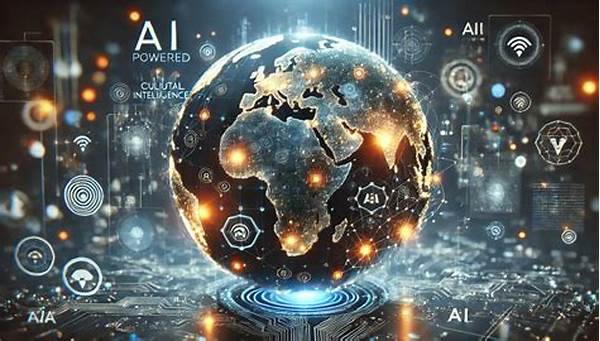How AI Supports Multi-Language Work Environments
In today’s bustling global economy, businesses transcend borders, reaching customers and hiring talent from around the world. This international expansion necessitates diverse, multi-language work environments that allow companies to communicate effectively across cultures. However, linguistic diversity, while enriching, also presents significant challenges. Misunderstandings in communication can lead to inefficiencies, errors, and lost opportunities. Enter the versatile capabilities of Artificial Intelligence (AI). How AI supports multi-language work environments is a game-changer that addresses these issues with precision and adaptability.
Read More : Why Ai Chatbots Are Essential For Businesses
Consider a global corporation with offices in Tokyo, Paris, and New York. Employees in each office may need to collaborate on projects requiring clear and accurate communication. Language barriers can become obstacles, but AI’s robust translation and interpretation features offer solutions that are as dynamic as they are essential. AI technology, such as real-time translation tools and multilingual chatbots, is reshaping communication landscapes by ensuring everyone is on the same page, regardless of their native language.
Furthermore, AI tools are doing more than just translating; they’re interpreting nuance and context, which are critical in any communication but particularly in business scenarios. By using complex algorithms, AI can adapt to specific terminology, industry jargon, and even cultural context, providing translations and interpretations that are as accurate and culturally relevant as possible. This level of sophistication ensures that businesses can maintain efficiency and connectivity across language divides.
In this evolving digital era, the question is no longer whether AI can assist in business operations but how AI supports multi-language work environments to create seamless communication platforms. As corporations blend AI into their daily operations, it’s essential to understand its transformative impact on how businesses function globally. How AI supports multi-language work environments is not just a feature—it is fast becoming an indispensable business tool.
AI’s Transformative Role in Multi-Language Workplaces
Introduction to AI’s Impact
Businesses today are set in the challenge of navigating multi-language environments that require adeptness and practicality. AI is emerging as a sophisticated ally in overcoming these challenges, facilitating effortless communication, and breaking down language barriers in the workplace.
The brilliance of how AI supports multi-language work environments can be observed in its ability to merge technological advancement with linguistic proficiency. Employees can communicate with each other more effectively, leading to enhanced productivity and collaboration. AI’s precise language interpretation capabilities ensure that meanings don’t get lost in translation, preserving the authenticity of communication.
Think of how many times you’ve encountered a quirky translation error on a website or an amusing advertisement where intent got jumbled due to poor language conversion. AI negates these lost-in-translation moments by offering more contextual understanding, bringing a sense of humor to navigating through errors while improving accuracy.
AI is an exclusive yet accessible service for all size businesses willing to invest in efficiency, from small startups inspired to go global to well-established corporations expanding their international reach. Many companies offer testimonial examples of success and enhanced global operations due to AI support in language services.
Industry research and statistical analysis prove that companies integrating AI into their multi-language strategies see reduced communication errors and improved turnaround times for projects. How AI supports multi-language work environments is echoed in glowing reviews and success stories circulated within executive boardrooms and employee newsletters.
How AI Enhances Global Wings
No longer is it merely about adding value—AI’s role in language services is an essential part of business operations, a perspective every forward-thinking enterprise is eager to embrace. With platforms developed through in-depth research and user feedback, AI is revolutionizing how multilingual dialogue progresses across dynamic industries.
Fostering Global Connectivity with AI Support
1. Efficient Communication: AI tools eliminate language barriers by translating communications in real-time.
2. Cultural Sensitivity: Understanding cultural aspects during translation is AI’s forte, reducing the risk of misinterpretation.
3. Cost Efficiency: AI reduces the need for human translators and can handle multiple tasks simultaneously.
4. Instant Translations: AI offers instant translation services, leading to faster decision-making and execution.
5. Customizable Solutions: Companies can adapt AI technologies to fit their specific industry vocabulary and needs.
6. Seamless Integration: AI integrates effortlessly with existing technology setups within organizations.
7. Scalable Technology: As companies grow, AI technologies grow with them without needing additional resources.
8. User-Friendly Interfaces: The AI tools are intuitive, ensuring ease of use for all employees.
Driving Business Objectives with AI
The business landscape is continuously shaped by the need for effective communication in diverse environments. It becomes vital to employ tools that streamline operations without the need for extensive manual interventions. How AI supports multi-language work environments is about driving results, enhancing connectivity, and fostering a culture of inclusivity within corporations.
By offering exceptionally reliable translation services, AI technologies enhance interactions between global teams. This fosters a smooth workflow, whether brainstorming solutions, executing projects, or even handling customer service queries. Employees feel more empowered and connected, driving efficiency and enhancing morale, ultimately leading to better output.
AI-powered tools are more than mere technological solutions; they are allies in creating an equitable workspace where every voice is heard and understood. By promoting a collaborative environment, AI sets the foundation for new synergies across departments and geographies, aligning with business strategies and goals.
Several brands have taken the spotlight with innovative uses of AI in multilingual settings, creating a narrative of progress and adaptability. By employing AI, businesses not only adapt to global demands but also position themselves as pioneers in the industry, leveraging technology to redefine success.
Analyzing AI’s Practical Implications in Business
The ever-evolving landscape of AI translates metaphorically to having a guide through the maze of global communication challenges. Understanding the complexities of language and cultural sensitivity is no longer daunting with AI tools at the helm. Integrating such powerful technology in the workplace reflects strategic thinking and a commitment to excellence.
Real-Life Usability of AI in Language Support
1. Real-Time Language Support: AI facilitates instantaneous language support, minimizing delays.
2. Comprehensive Insight: Offers insights into regional dialects and recognizes language trends.
3. Productivity Enhancement: Speeds up processes, allowing for more time for strategic thinking.
4. Eliminating Human Errors: AI’s precision reduces the likelihood of errors, ensuring high accuracy.
5. Personalized Experience: Tailors user interaction based on specific needs and language preferences.
6. Robust AI Training Models: Continuously updates models to match linguistic evolution and business changes.
7. Secure Workflow Processes: Maintains high security while handling sensitive communication.
8. Global Client Interaction: Enables smoother interactions with international clients and partners.
9. Competitive Advantage: Keeps businesses ahead by managing multiple languages efficiently.
10. Adoption Ease: The adaptability of AI facilitates easy adoption across varied business settings.
Conclusion: AI’s Language Revolution
The evolution of AI in supporting multi-language work environments is an impressive narrative of innovation intersecting with everyday business operations. From fostering seamless communication to nurturing a global workforce, AI serves as a linchpin in refining how companies navigate linguistic diversity.
AI proves to be not just a technological advancement but a strategic cornerstone for businesses aiming to expand their global reach efficiently. With its unique capabilities, AI presents an enticing proposition for future-oriented firms focused on leveraging cutting-edge solutions to stay competitive.
How AI supports multi-language work environments extends beyond providing translations; it redefines collaboration, opens new avenues of understanding, and solidifies professional bonds across territories, creating a united, thriving global business environment.


